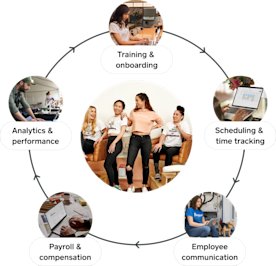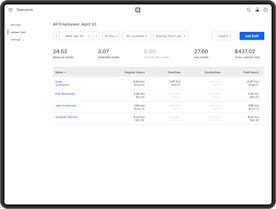- All resources
- Manage employees
- Topic overview
Intro to employee management.
Strategies for saving time and improving the employee experience.

As the owner or manager of a small business, there’s a lot to figure out when it comes to team management. With training and onboarding, scheduling and coordinating payroll tasks, it’s easy to spend hours every week on time-consuming operational tasks and lose track of the overall employee experience.
In this guide, we’ll break down the employee management workflow and share some strategies to free up time and create positive employee experiences that can help you boost morale and improve retention. Note, this guide is for educational purposes only. For specific advice, be sure to consult with a professional.
What is employee management?
As the name suggests, employee management is the process of putting procedures, strategies and processes in place to manage your staff and their experience. However, it’s not simply the work that comes with managing others – it’s about creating an environment of positivity, motivation and encouragement to boost productivity and performance.
Having a best-in-class employee experience helps all team members feel supported, appreciated and enjoy showing up to work each day. Not only that, but increasing employee engagement can have a real impact on your bottom line.
Defining the employee management workflow
Managing a small business day-to-day can seem like an endless stream of tasks, people and responsibilities constantly vying for your attention. In order to create a positive experience for your staff, it is helpful to think about employee management as a workflow consisting of five distinct phases: training and onboarding new team members, scheduling your team and tracking time, on-going communication, payroll and compensation, and finally analytics and performance.

Let’s take a look at each of these areas in more detail and the tools and strategies you need to streamline your workflow from end to end.
Organize training and onboarding

With filling out documents, learning new tools and processes and acclimatizing to a new workplace, a team member’s first days and weeks can be overwhelming for the employee and manager alike. That’s why having a documented onboarding plan is a good first step to improving the overall employee experience. Having one will not only help you stay organized, but it will also make it easier to delegate this responsibility to another manager in the future, should you choose.
The onboarding process will look different at every company, but it’s a good idea to have a plan to collect new-hire details like contact information and social insurance number, as well as other important documents, such as W2s. Your plan should also include steps to train staff and get them set up on the tools and software they will need to do their job.
Streamline scheduling and timecards

For many small businesses, building weekly schedules and managing timecards can be one of the most time-consuming management tasks. Matching open shifts with availability, all while balancing hours and labour costs, is no small feat. And once the schedule is published, employees need an easy way to view their scheduled hours, let you know about any last-minute conflicts, log their time and clock in and out for breaks.
If you’re using a spreadsheet or pen and paper to manage this process, it might be time to look into scheduling and time-tracking tools to help streamline your workflow. For example, businesses that run on Square have access to an unified employee management system where they can build online shift schedules and publish them directly to an app on their employees’ phones. Employees can clock in and out from the app or point of sale, and everything syncs on the back end.
Improve employee communication

It may sound obvious, but effective communication is an essential aspect of improving the employee experience. It’s a manager’s responsibility to make your staff feel supported and have what they need to succeed, and that starts by having tools and strategies to ensure you communicate effectively and set expectations with your team.
Increasingly, employees expect their employer to use digital methods to send updates and share important information. And while text and email can be effective communication tools, it’s easy for information to get lost or buried. That’s where employee management software comes in to help you reach your team in the right context and help them find the information they are looking for, whether it’s to view their schedule, find their pay stub or call in sick.
Make more informed decisions

The last phase of the employee management workflow is all about using your employee performance data and analytics to make informed decisions about your company. Your schedules and time cards, sales reports and weekly payroll generate a lot of employee information that can help you monitor the health of your business and improve employee engagement. But the data is only as good as your ability to access it.
Having the right tools in place makes it easy to surface insights that you can use to understand team activities like the number of hours worked, overtime or who’s generating the most sales or loyalty program signups. It also helps you answer questions like do you need to hire more staff, or should you adjust your business hours to accommodate increased or decreased demand.
Ultimately, the answers to these questions should feed back into the start of your employee management workflow to help you grow your business and create positive employee experiences.

Check out more guides to help you optimize all sides of your business.

